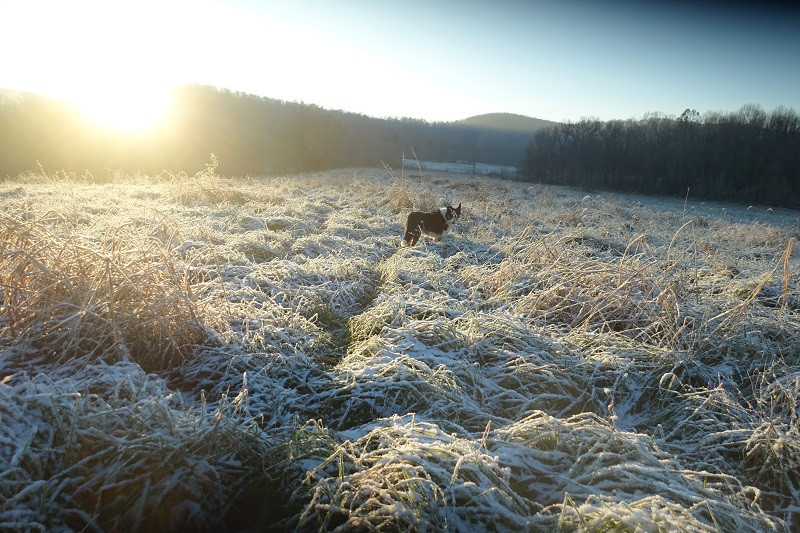The Giving Earth
posted on
December 13, 2018

Bo is checking fences before cows enter this beautiful field of stockpiled fescue.
This pasture hasn't been grazed since the end of July, enjoying four months of rest and regrowth. We moved cows into this field this past Friday, after sorting through them one last time before breeding starts this Saturday coming. Tall frosted fescue is a high-protein and high-energy feed, which cows savor. Fescue can be infected with a fungus during the heat of the summer that is rather unpalatable. But once frost arrives, the fungus dies and sugar levels rise in the plant, making it highly palatable and nourishing. Abundant grass thankfully stands in this field, and it will probably supply the herd of 80 cows and calves with feed for 15 - 20 days. The power of soil to provide so much nutrition for so many animals is inspiring.
The soil we affect through management of grazing and wetlands is about 3 feet of depth. What transpires, however, further down? The flow of water, movement of rock, development of heat and cold, creation and storage of minerals all speak to a profound and rich life deep in the earth that is obscure but invaluable to most of us.
The earth is incredibly generous, and its story may be analogous to Shel Silverstein's The Giving Tree. It seems that no matter how much we abuse it, it keeps giving back, even in an exhausted state. The stump of the once thriving tree supports the old man, as a bench, in the end, generously supporting he who had consumed its during his era of greed. How forgiving and loving. So it is with the earth.
We are being reminded of this as we install geothermal heating for our house. The earth offers 55 degrees of temperature at no cost, which can then be compressed through a heat exchanger to deliver 70 degrees to a home at very low marginal expense. In the picture below, a loop of polyethelene hose is place into five wells (per furnace) 150 feet deep. Tubing and wells are then insulated with a pumice-like material to minimize loss of temperature. The wells are connected together and an oil-based liquid is injected into the piping to be circulated by a pump, faithfully delivering 55 degrees of temperature to the heat compressor year around. So simple and so abundant.
The earth is always giving, whether it be stockpiled fescue for livestock, warm air for the winter, or cool air for the summer, as just a few of infinite examples. It is always giving.

As mentioned, we sorted through the cow herd last Friday, replacing lost eartags, and moving unbred cows to the meat herd. We also sorted some bred cows and their calves out of the breeding herd, either because of poor temperament or poor body-condition. We used to give cows two or three chances at breeding before pulling them from the herd, but now that cow numbers are higher, we only give one chance. Fertility is the second most important criterion for membership in the herd. Temperament is the first, as dangerous animals do not make for welcome partners. Red Devons are generally docile, which is a key reason we selected this breed.

As cold weather sends us inward, slow-cooked foods from the oven warm us. Below is a recent dinner of lamb shanks, chard, beans, and polenta. Shanks were cooked for ten hours at 200 degrees with stock, wine, and herbs. So sumptuous.

As the season of giving is upon us, we have gift packs of prepared foods available as well as gift certificates. Gift Packs consist of 23 servings of 8 of our prepared foods, all of which take less than 15 minutes to heat up: Beef Barbacoa, Pork Ragout, Sliders, Short Rib Burgers, Chili, Meatballs, Bolognese Sauce, and Italian Sausage. 20% savings over buying individually. Order here and we will have them for you either this Sunday or next.
CertificatesMay the infinitely giving earth be with each of us.




